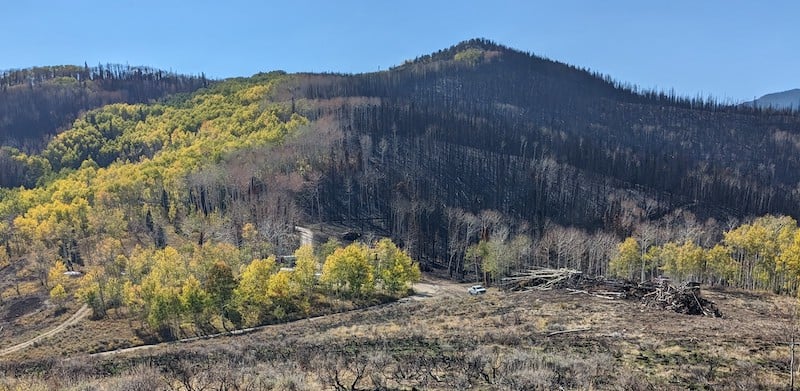As a hot, dry fire season settles in across much of the western United States, land managers are looking for anything that might slow or stop inevitable wildfires. And one solution might be standing in plain sight.
For years, conventional wisdom held that stands of aspen trees could resist wildfires, often slowing a fire’s advance or changing its course. Now, new research from Western Colorado University’s Clark School of Environment and Sustainability is adding data to the anecdotes.
The research, titled Aspen impedes wildfire spread in southwestern United States landscapes and published today in the journal Ecological Applications, analyzed 20 years of fire behavior across more than 300 wildfires in the Four Corners region. What the team found was that even modest increases in aspen cover dramatically reduced the rate at which fires spread.
Some of the study’s key findings were:
- Fires in areas with vegetation comprised of at least 25% aspen spread at about a third the rate of fires in forests with less than 10% aspen trees.
- Aspen was more abundant at the edges of fires, where fires stopped, than in burn interiors, indicating that aspen can not only slow a fire but also stop it or change its course.
- Aspen forests can act as natural firebreaks, with applications in communities and sensitive areas prone to wildfire.
According to the study, it has long been understood that aspen is more resistant to burning because of higher moisture content in an aspen stand’s foliage and understory, high branches, and chemical differences that reduce flammability. But prior to the team’s research, the extent to which aspen slows or stops the advance of a fire relative to conifer forests hadn’t been quantified. In particular, the team found that differences in spread persisted even under extreme fire weather conditions, which are expected to become more common in a warmer, drier future.
Matt Harris, the study’s lead author and a recent graduate from Western’s M.S. in Ecology program, said, “My hope is that this research can help inform fire and fuels management focused on propagation of aspen through prescribed fire, and how aspen can even be planted around communities to form green fuel breaks for fire protection.”
The study also calls attention to the importance of the federal research infrastructure that makes this kind of work possible. Harris and his advisor, Dr. Jonathan Coop, collaborated with scientists from the U.S. Forest Service’s Rocky Mountain Research Station and Colorado State University, relying on fire and vegetation data funded and maintained by federal agencies.
“This research is a direct result of long-term federal investment in understanding wildfire and forest dynamics,” Coop, a professor of Environment and Sustainability at Western’s Clark School and a co-author of the study, said. “The wildfire challenges we face in the western U.S. continue to grow every year, and we require good science to inform solutions to protect communities and sustain the forest ecosystem functions we depend on, from water to timber.”
To read the full paper, visit: https://esajournals.onlinelibrary.wiley.com/doi/10.1002/eap.70061
Want to be a part of the story?
At the Clark Family School of Environment & Sustainability, students dive into immersive, real-world experiences that spark bold ideas and lasting change. Discover our programs and start shaping a better tomorrow.


